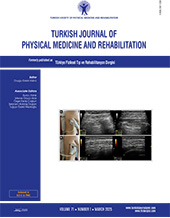Feasibility study of core training in knee injury recovery
2 Department of Orthopedics, Peking University Third Hospital Qinhuangdao Hospital, Qinghuangdao, China DOI : 10.5606/tftrd.2024.12985 Objectives: This study aims to investigate the effects of core and routine training on joint function, anterior tibia translation and balance in patients with knee joint injury.
Patients and methods: Between March 2021 and March 2022., a total of 70 patients (49 males, 21 females; mean age: 31.2±5.3 years; range, 17 to 44 years) with knee ligament injury or meniscus injury were included. The patients were divided into core training group (n=35) and conventional training group (n=35) by matching method. During the recovery process, the regular training group performed routine training, whereas the core training group engaged in core training. Both groups were trained for a total of eight weeks. After training, the Visual Analog Scale (VAS), knee Lysholm score, KT-2000 tibial anterior translation, and the star excursion balance test (SEBT) results were collected.
Results: The mean VAS scores in both groups were decreased from baseline values. The mean Lysholm score increased from baseline data; the degree of tibial anterior translation decreased compared with baseline data (p<0.05). The mean SEBT scores showed significant improvement over baseline data. In contrast with the routine training group, the mean VAS score of core training was lower and the total score of Lysholm was higher (p<0.05). When bending the knee at 90°, the mean tibial anterior translation was 3.87±1.23 mm in the core training group, significantly lower than in the regular training group (p<0.05). The SEBT results showed that, after eight weeks of training, healthy and injured legs in core training group exceeded those of the regular training group in the farthest distance (p<0.05).
Conclusion: Our study results indicate that core training is more successful than regular training in reducing pain, and it can ameliorate the dynamic balance stability of patients with knee injury.
Keywords : Core training, injury, knee joint, regular training, rehabilitation

















